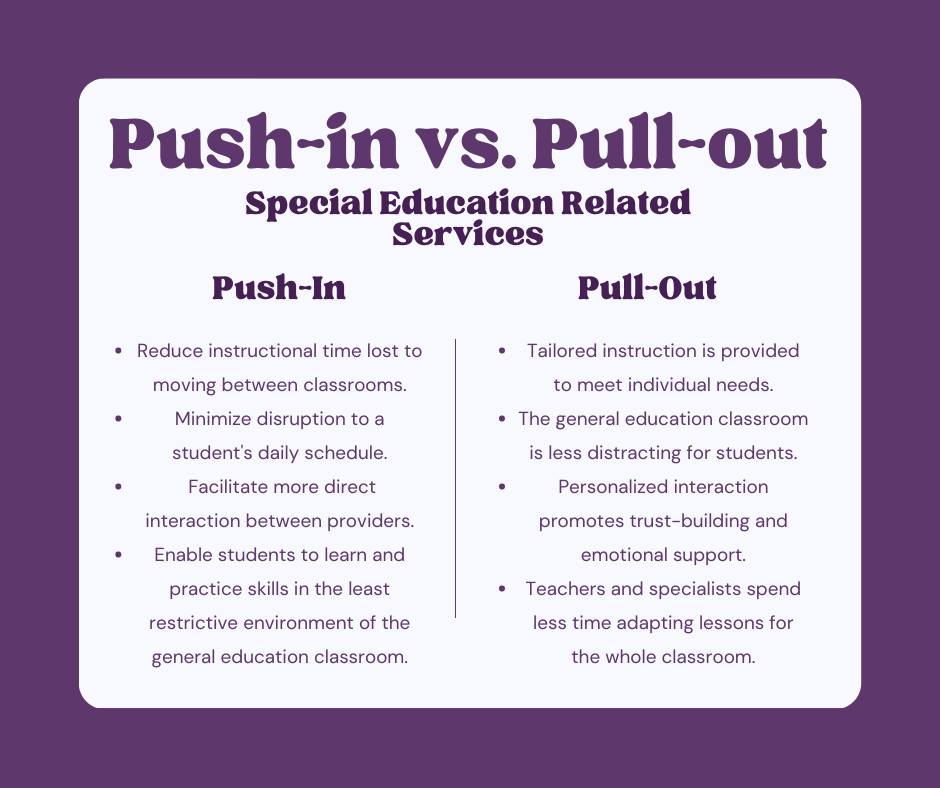As parents and caregivers, we want the best education and support for our children, especially those with Individualized Education Programs (IEPs). In the quest for providing tailored assistance, schools offer various specialized services, including both push-in and pull-out services. This article aims to explore the benefits and drawbacks of both approaches, empowering parents with the necessary information to make informed decisions about their child’s education.
Understanding Push-In and Pull-Out Services:
Push-In Services: Push-in services involve bringing special education professionals, such as speech therapists or occupational therapists, into the general education classroom to provide services to students alongside their peers.
Pull-Out Services: In contrast, pull-out services entail students with IEPs leaving the general education classroom for specialized support in a separate setting, such as a resource room or therapy room.
Benefits of Push-In Services:
- Inclusive Learning Environment:
- Students with IEPs are integrated into the general education classroom, fostering a sense of belonging and reducing stigmatization.
- Opportunities for social interactions with typically developing peers help develop social and communication skills in a natural setting.
- Reduced Disruptions:
- Push-in services minimize disruptions in the classroom, as students receive support within their regular learning environment.
- Positive Impact on Classmates:
- Typically developing students gain exposure to neurodiversity and learn to appreciate the unique strengths of their peers with IEPs, promoting empathy and inclusivity.
Drawbacks of Push-In Services:
- Limited One-on-One Time:
- The individualized attention a student receives from specialized professionals may be constrained in a busy classroom setting.
- Balancing Individualized Needs:
- Striking a balance between the unique needs of students with IEPs and the broader educational goals of the class can be challenging.
Benefits of Pull-Out Services:
- Intensive Support:
- In a separate setting, students can receive focused and individualized attention, addressing their specific learning needs.
- Targeted Instruction:
- Pull-out services allow for tailored instruction, enabling educators to implement personalized learning strategies.
- Reduced Classroom Distractions:
- The controlled environment of pull-out services minimizes distractions, enhancing the student’s ability to concentrate and learn.
Drawbacks of Pull-Out Services:
- Potential Stigmatization:
- Students may feel singled out or different when leaving the general education classroom for specialized support.
- Missed Classroom Time:
- Students in pull-out services may miss valuable instructional time in the general education setting.
- Limited Social Interaction:
- Reduced exposure to typically developing peers might hinder opportunities for socialization and communication practice.
Both push-in and pull-out services offer valuable support to students with IEPs, each with its own set of advantages and drawbacks. Push-in services promote inclusivity and allow for natural social interactions, benefiting both students with IEPs and their typically developing peers. On the other hand, pull-out services offer intensive and targeted support, addressing individual learning needs more comprehensively. As parents, it’s essential to engage in open communication with your child’s IEP team to understand the available options and determine the most suitable approach for your child’s education journey. By working together, we can create a supportive and inclusive learning environment in line with the principles of IDEA.

